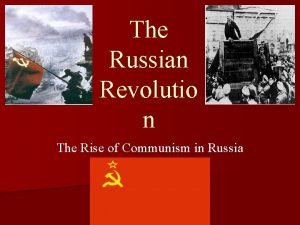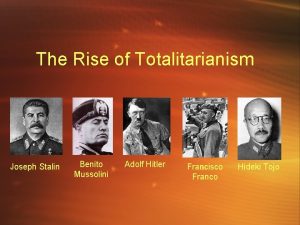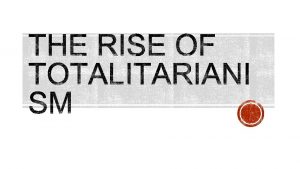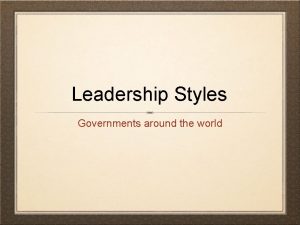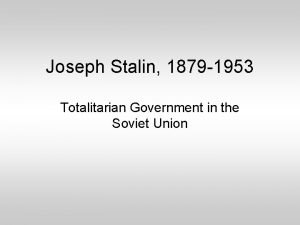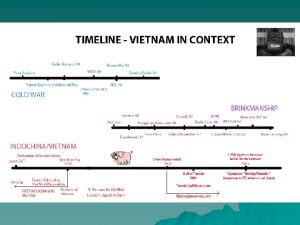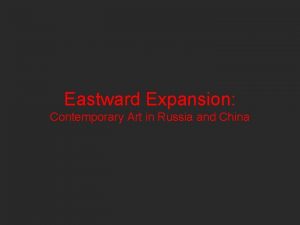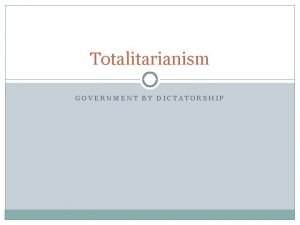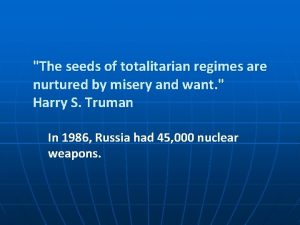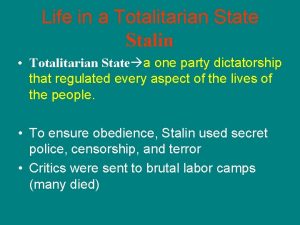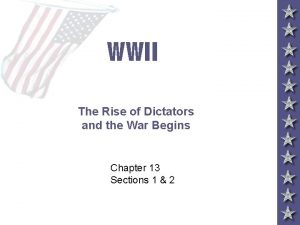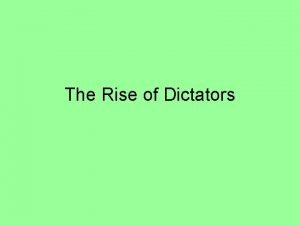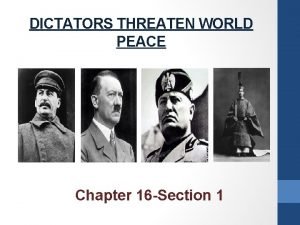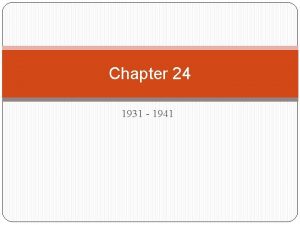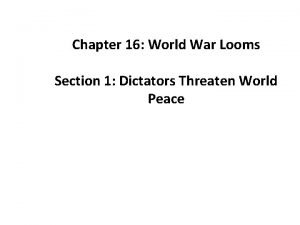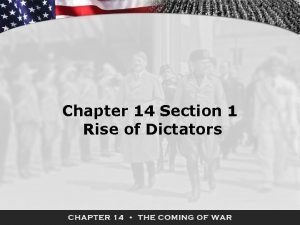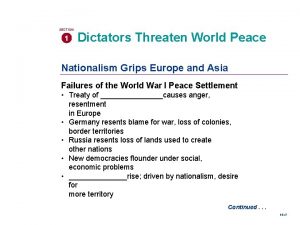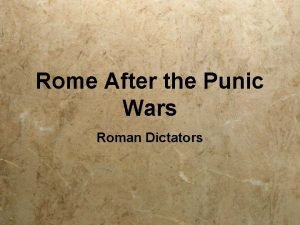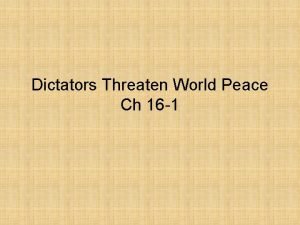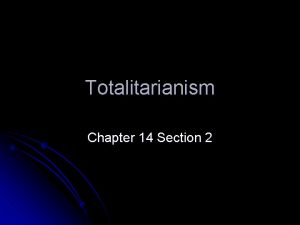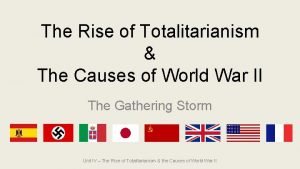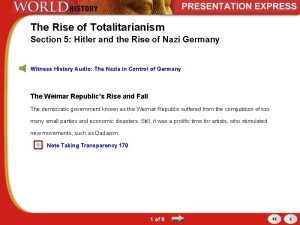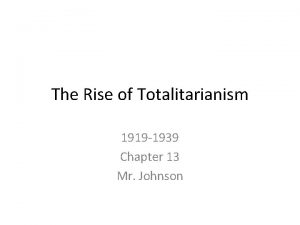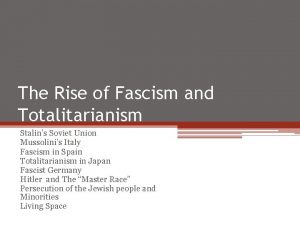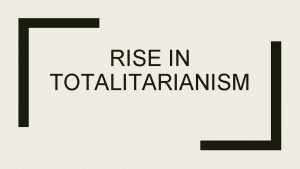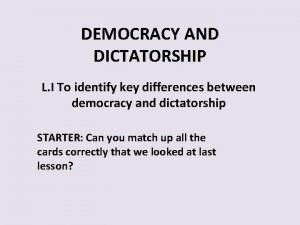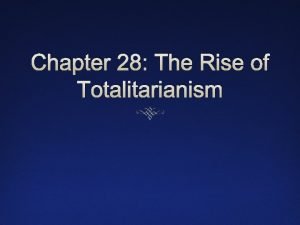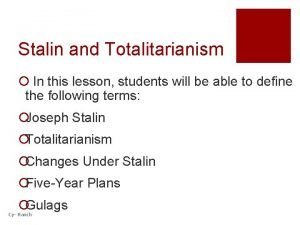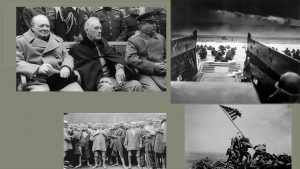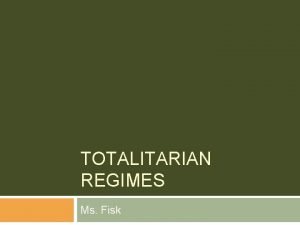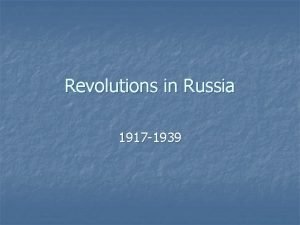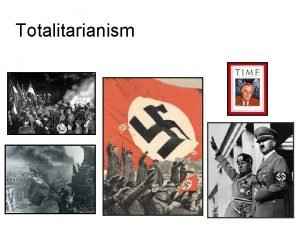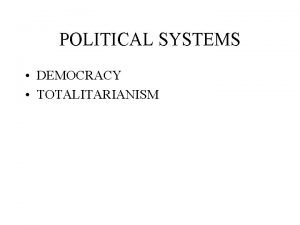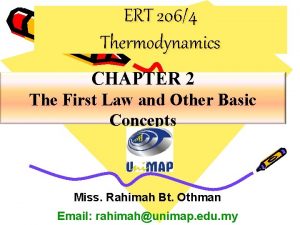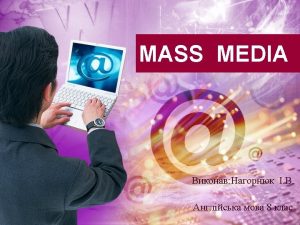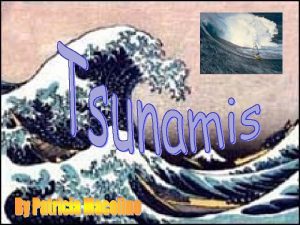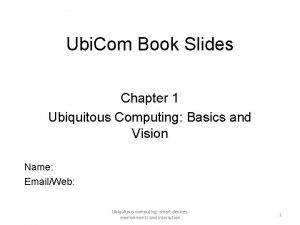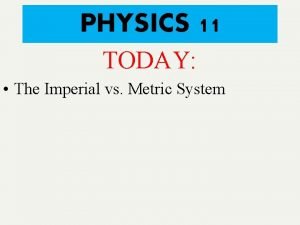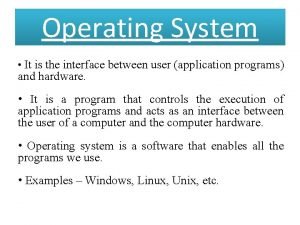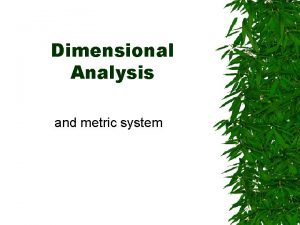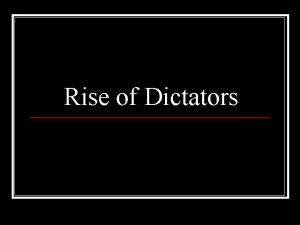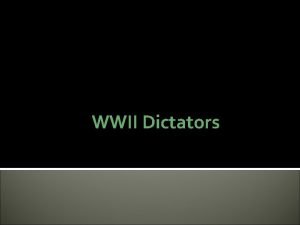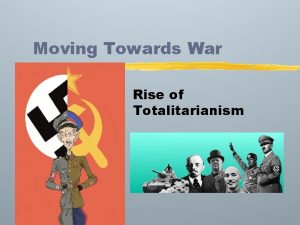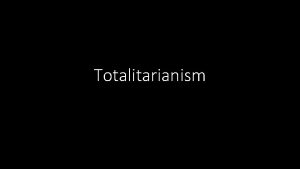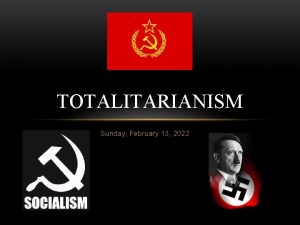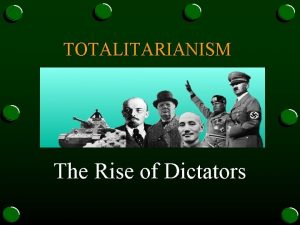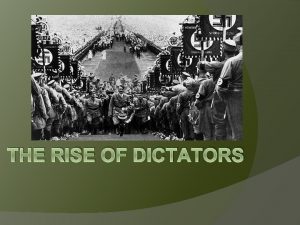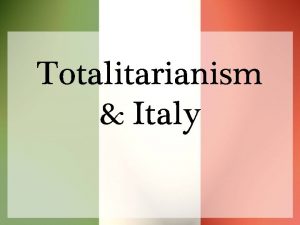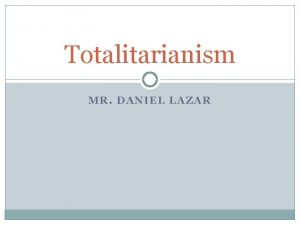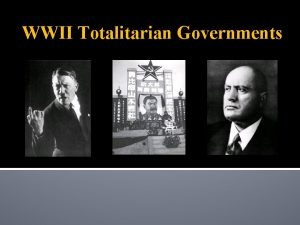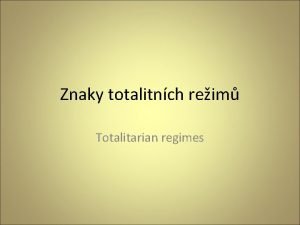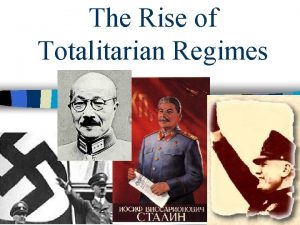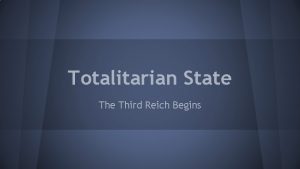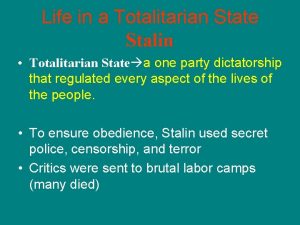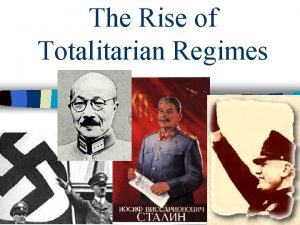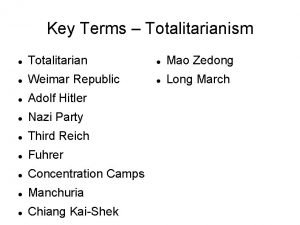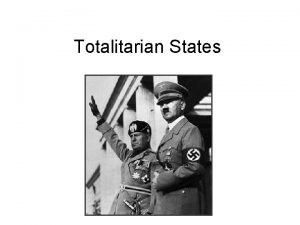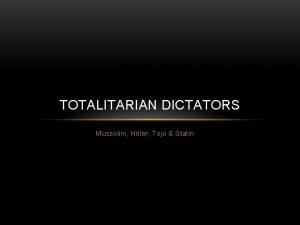TOTALITARIAN DICTATORS Totalitarianism Definition System in which a















































- Slides: 47

TOTALITARIAN DICTATORS

Totalitarianism- Definition System in which a government seeks total control of its citizen’s lives Favors security and state power over individual freedoms and thought

Totalitarianism- Characteristics Glorification of the State Control One-Party Rule Charismatic, Authoritarian Rulers Control of Media Police Terror

Stalin’s Soviet Union

USSR under Lenin Oppositions parties outlawed Secret Police (Cheka) instill fear New Economic Policy � Lenin’s capitalist compromises to fix economy Farmers allowed to sell surplus crops Free small industry Invites foreign investment


Joseph Stalin Becomes secretary of the Central Committee Takes over after Lenin’s death 1924 � Forces Leon Trotsky into exile

5 Year Plans 1928, 1933 Stalin’s plans to build Soviet industry � Impose central planning � Catch up to western industry Set high quotas, limited consumer goods Makes substantial improvements


Collectivization Government seizure of farm land Peasants forced onto large gov. farms � Many resist 5 -10 million dead Food production increases

State Control NKVD- Stalin’s secret police Gulags- Government labor camps Pravda- State run newspaper Indoctrination used to build up reverence for Stalin Suppress religion



Great Purge 1934 -1938 Stalin’s persecution of old Bolsheviks who threatened his power 8 -13 million killed



Mussolini’s Italy

Fascism Political movement following WWI that stressed: � Extreme Nationalism � Authoritarian Leadership � State Supremacy One Party Rule Lack of Individual Rights

Benito Mussolini Militant, Nationalist, Anti-Communist, news editor Starts the Fascist party 1921 � The “Black Shirts, ” gangs of fascist thugs terrorize socialists Takes power during postwar struggles � After Socialists win parliamentary seats leading to class tension in Italy, appealing to desire for order and protection

Rise to Power Takes power during postwar struggles � After Socialists win parliamentary seats leading to class tension in Italy, appealing to desire for order and protection Fascist march on Rome 10/1922 � King Victor Emmanuel III asks Mussolini to form government, rule as Prime Minister

Fascist Italy Change election law to give Fascists full control � Then pass laws giving Mussolini power, dissolving opposition parties � Mussolini takes title of “Il Duce, ” “the leader” Ends free press, labor unions Corporatism- creates group of business leaders who manage economy Encourages women to stay home, have children, abolishes divorce Never a real totalitarian state


Lateran Accords 1929 Deal with Catholic Church � Gives Pope autonomy in Vatican City & cash � Pope recognizes Italy and Mussolini

Hitler’s Germany

Nazism “National Socialism” Extreme Nationalism, Racism Authoritarian Leadership Modified socialism Call for repudiation of Versailles Treaty, Unification of Ger. & Aus. , Exclusion of Jews, end of Weimar Republic

Adolf Hitler Austrian artist, WWI vet (Ger. ) Becomes “Der Fuhrer” (the leader) of Nazi Party after WWI


Rise to Power Nazis form the SA (The Brown Shirts), Nazi thugs to harass opponents Appeal to lower middle class during economic troubles, blame Versailles and Weimar Failed Beer Hall Putsch (1923) � Short prison sentence, writes Mein Kampf

Rise to Power Weimar is paralyzed by weak coalition governments and Great Depression Hitler named Chancellor by President Hindenburg � Hope to manipulate Hitler and his voter appeal Fire set at Reichstag building, Nazis blame communists, jail many � Calls on Right wing parties to join the Nazis � Win in Reichstag elections









Rise to Power The Enabling Act- gives dictatorial powers to Hitler “Night of Long Knives”- Hitler eliminates Brown Shirts (SA) who may not be loyal � Uses new secret police force, The Gestapo and personal bodyguards, The SS Conducts plebiscite to show public approval



Nazi Germany Military swears allegiance to Hitler personally Schools, youth groups used for indoctrination � Dissenting books burned, degenerate art destroyed � Huge propaganda campaigns, staged rallies Rearms German military � Creates jobs and industries, defies Versailles treaty � Britain and France do nothing Massive public works projects � Ex: The Autobahn

Anti-Semitism Nazis blame Jews for loss in WWI and economic troubles � Lead boycotts of Jewish owned stores “Nuremburg Laws” (1935) strip Jews of citizenship Kristallnacht (1938): night of organized violence against Jews



Hitler’s Foreign Policy Demands return of Saar Coal mines, Polish Corridor, the Rhineland Desires conquest of “Lebensbraum, ” living space for the Aryan “master race”


 Russian revolutio
Russian revolutio Totalitarian vs authoritarian
Totalitarian vs authoritarian Education in totalitarian state
Education in totalitarian state Totalitarian management style
Totalitarian management style Stalin's totalitarian state industrial policies
Stalin's totalitarian state industrial policies Totalitarian
Totalitarian Totalitarian architecture
Totalitarian architecture Totalitarianism pros
Totalitarianism pros The seeds of totalitarian regimes are nurtured
The seeds of totalitarian regimes are nurtured Life in a totalitarian state
Life in a totalitarian state Rise of dictators graphic organizer
Rise of dictators graphic organizer Types of dictatorship
Types of dictatorship Chapter 16 dictators threaten world peace
Chapter 16 dictators threaten world peace Dictators threaten world peace chapter 24 section 1 answers
Dictators threaten world peace chapter 24 section 1 answers Dictators threaten world peace
Dictators threaten world peace Dictators threaten world peace chapter 24 section 1 answers
Dictators threaten world peace chapter 24 section 1 answers Chapter 14 section 1 dictators and war
Chapter 14 section 1 dictators and war Dictators threaten world peace
Dictators threaten world peace Rome after the punic wars
Rome after the punic wars Chapter 16 dictators threaten world peace
Chapter 16 dictators threaten world peace Chapter 14 section 2 totalitarianism
Chapter 14 section 2 totalitarianism Pearl harbor date
Pearl harbor date The rise of totalitarianism section 5 quiz
The rise of totalitarianism section 5 quiz Chapter 13 the rise of totalitarianism
Chapter 13 the rise of totalitarianism Fascism vs totalitarianism
Fascism vs totalitarianism Totalitarianism vs fascism
Totalitarianism vs fascism Totalitarianism vs democracy venn diagram
Totalitarianism vs democracy venn diagram The rise of totalitarianism section 1 quiz answer key
The rise of totalitarianism section 1 quiz answer key Pictoword for democracy
Pictoword for democracy Fascism vs totalitarianism
Fascism vs totalitarianism Totalitarianism lesson plan
Totalitarianism lesson plan The that hitler war
The that hitler war Traits of totalitarianism
Traits of totalitarianism Why did the czars resist change
Why did the czars resist change Totalitarianism
Totalitarianism Secular totalitarianism
Secular totalitarianism Control mass
Control mass Is the earth a closed system
Is the earth a closed system Digestive system respiratory system and circulatory system
Digestive system respiratory system and circulatory system Sea tongue twisters
Sea tongue twisters If two witches would watch
If two witches would watch Japanese word for wave
Japanese word for wave Smart dei model in ubiquitous computing
Smart dei model in ubiquitous computing Metric system units
Metric system units What type of plan shows the layout of the hvac system
What type of plan shows the layout of the hvac system Interface between user and kernel
Interface between user and kernel Which country does not use the metric system
Which country does not use the metric system Which type of drainage system drains spaces forward and aft
Which type of drainage system drains spaces forward and aft
